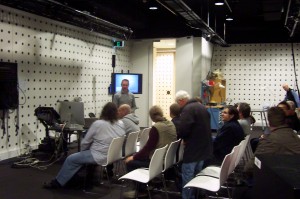RMIT’s Spatial Information Architecture Laboratory
On Monday June 2nd Associate Professor Lawrence Harvey and AES stalwart & PhD candidate Jim Barbour hosted twenty Section members and guests at the SIAL Sound Studios at RMIT’s Design Hub in Carlton.
After a brief tour of the main performance space, we were ushered into the main experimental space, where two areas were available – The Equidome, a large area with overhead truss-work where 3-Dimensional speaker installations were installed, and The Pod, a sound booth with comprehensive surround speaker installation and multichannel audio composition and editing capabilities.
Lawrence explained that the Spatial Information Architecture Laboratory (SIAL) was part of RMIT University’s School of Architecture and Design.

He explained that they were involved in three primary activities: Urban Soundscapes, Acoustic Design Resources, and Spatial Sound Composition and Performance.
He showed a range of examples of Urban Soundscape projects, pointing out that these projects link undergraduate teaching to projects.
Examples included work on the Urban Soundscapes works in the city – at Northbank, Federation Square, and Birrarung Marr. The City of Melbourne commissioned Installation in a Laneway was also briefly described.
Lawrence then described the work they did with the City of Melbourne. Firstly he described the CitySounds1 Community Soundscape Survey, to identify public perceptions (positive and negative) of different elements of the natural city soundscape.
He then described the provision of an online Acoustic Design Resource, “CitySounds2” to assist city apartment developers, renovators, and purchasers to evaluate and improve the acoustic performance of their apartments.
He then went on to describe some of their composition and performance work, covering the inaugural concert series at the Melbourne Recital Centre, the Sound Bites City installation, some work done with the Town Hall organ, and an tour to the UK presenting a major new sound work at the Huddersfield Music Festival at the Huddersfield Town Hall.
We then moved to The Pod where Lawrence demonstrated the capabilities of the software/hardware components and played some examples of spatial sound compositions generated using it.
Following this, we moved back to the Equidome, where Jim Barbour took over.
He explained that his research project involves locating sounds in the listening space, principally looking at some of the issues with height – the nature of three dimensional space, and the sound characteristics that happen in three-dimensional space.
Jim then described the installed 12.2 system (including 6 overhead speakers) and outlined how he was able to create height information using convolution, as well as multi-microphone recording at the source. He also covered the challenges associated with real-time audio panning in three dimensions.
He played several audio examples, demonstrating how the sound changes with manipulation of the source audio in three dimensions.
We thank Lawrence and Jim for generously giving up their evening to host us for these very interesting presentations, and the site visit.
Useful Links:
SIAL Projects:
http://www.rmit.edu.au/architecturedesign/sial/projects
CitySounds2 Acoustic Design Resource (for apartment acoustic evaluation & design):
http://www.sound.sial.rmit.edu.au/ADR/ADROnline.html
The Urban Soundscapes:
http://www.sial.rmit.edu.au/portfolio/urban-soundscape-design/
Sound Bites City :
http://www.sial.rmit.edu.au/portfolio/sound-bites-city/
Huddersfield Town Hall – UK :
http://rmit.net.au/browse;ID=is5h2ax2c5b6z
